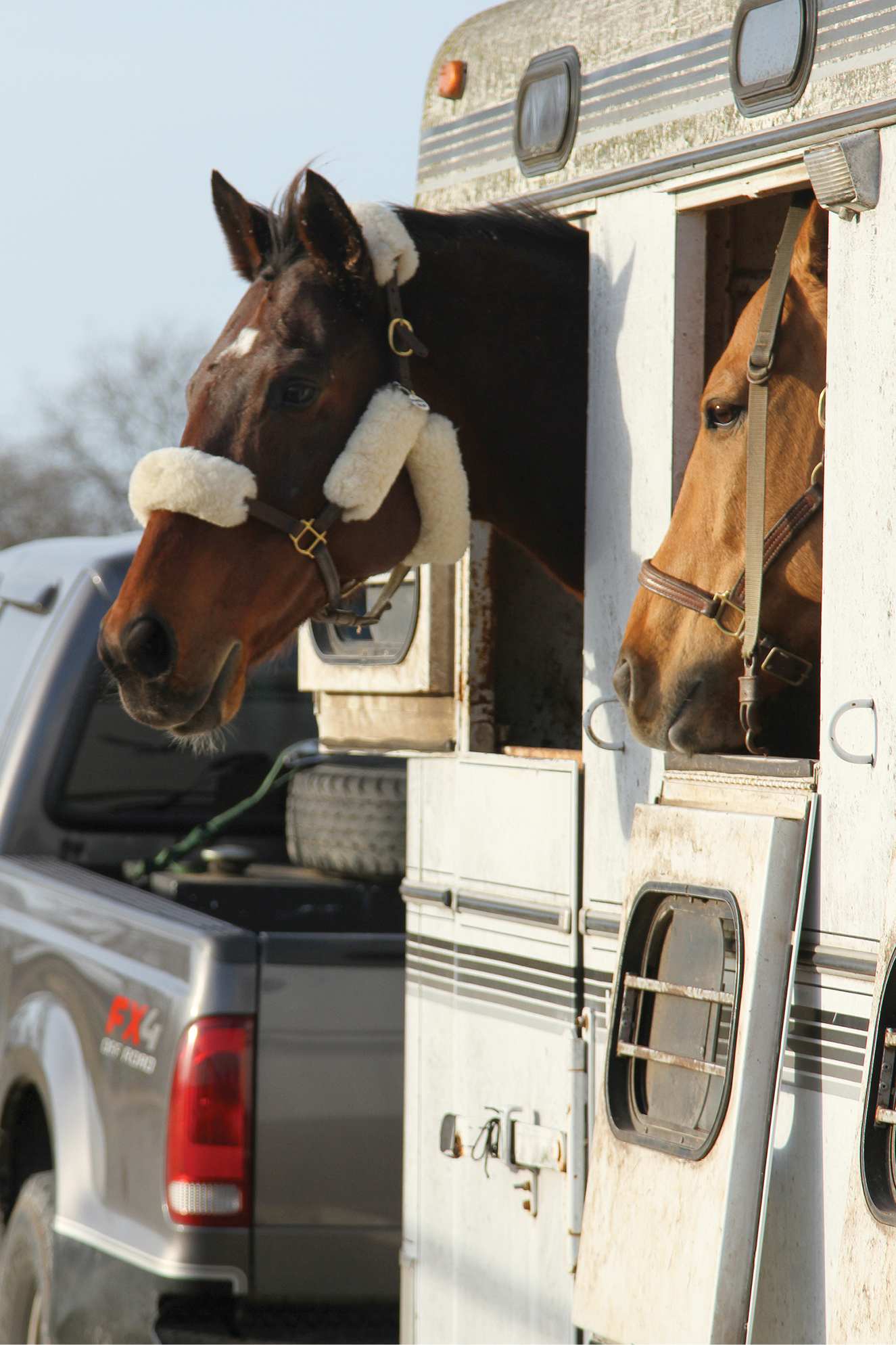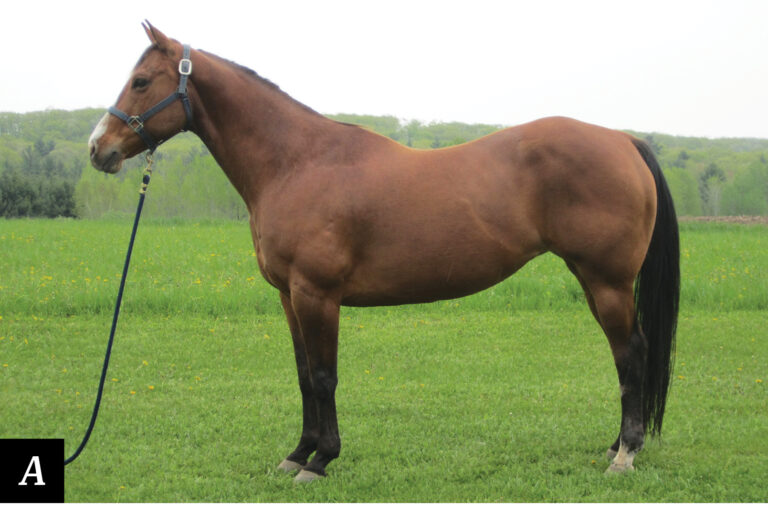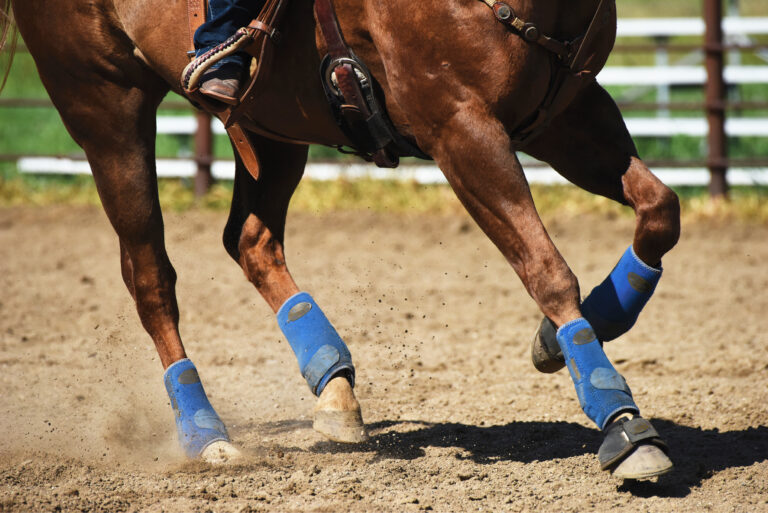A horse that’s difficult to load and haul is problematic. He’ll make you late to trail rides, lessons, horse shows, and veterinary appointments. Worse, his behavior can also spell disaster. Loading fights can result in injury to you or your horse, and scrambling during transit can create an unsteady trailer, a distracted driver, and, ultimately, an ugly traffic accident.
You can hardly blame a horse for being reluctant to load and haul. Stepping into a box not much larger than his body and riding quietly in bouncy confinement goes directly against his nature. Fortunately, there are methods of improving unwanted trailering behaviors.
Read About: Transforming Your Bad Hauler
I’m going to share some common scenarios related to loading and hauling, explain possible causes of the behaviors, and provide solutions so you can help resolve your horse’s trailering problems.

Read About: Troubleshooting Trailering
But First…
First, make sure pain isn’t a factor. If your horse’s behavior changes suddenly—for example, he begins uncharacteristically resisting loading or unloading—have your veterinarian evaluate him for pain and/or eye or neurological issues.
Also, be sure your trailer fits your horse in size and configuration. Some horses are more comfortable in slant-load trailers; others prefer a straight-load. Some do best with a ramp entry and others prefer a step-up. Any trailer should have adequate headroom and space to accommodate your horse’s body length comfortably.
With those caveats out of the way, let’s look at some other causes and solutions.
Refusal to Load
Your horse simply won’t get into the darn trailer. Some horses will stop a dozen feet or more away, frantically spinning and rearing; others will climb halfway in only to back right out again—repeatedly. Refusal to load is one of the most common and frustrating issues related to trailering.
Possible reason: Your horse never learned to be comfortable entering or standing inside the trailer. The solution is to change your horse’s mind about the trailer, convincing him that it’s an OK place to be. Go slowly with this reconditioning and reward every step your horse takes toward the trailer, using two methods.
The first is negative reinforcement, where you release pressure on the lead rope the moment he even thinks about taking a step forward, before asking again. The second is positive reinforcement, where you offer him something pleasurable (a small treat, verbal praise, scratching) whenever he steps forward. (Clicker training, left, can be especially useful here.)
Once your horse has entered the trailer willingly, let him spend some time there making positive associations—by eating hay or grain, being groomed, or visiting with a pal. Placing a happy-to-be-there equine friend in the adjoining space, to stand quietly next to your horse, helps through a process called social facilitation.
Possible reason: Lack of a reliable forward cue in the presence of adversity. If your horse doesn’t walk willingly forward when asked—and on a straight line—loading him into a trailer will be especially difficult. The solution is to establish a reliable forward cue, first in a neutral situation, then in the presence of “adversity”—such as a step-over pole or a wooden bridge on the way to the trailer. Once a reliable forward cue has been established, use it to practice entering the trailer.
Learn More: Trailering Tips with Monique Potts
Possible reason: A traumatic event. A horse that’s experienced trauma in the trailer may have a conditioned fear response; this will make him even more difficult to rehabilitate. The solution may require a professional’s help in designing and implementing a desensitizing and counter-conditioning plan. The basics will be similar to what I described for the horse that never learned to enter and stand in a trailer, only it’ll likely proceed more slowly in order to change the horse’s emotional response so that he anticipates good things.
The handler will need to be skilled at reading your horse’s body language in order not to proceed too fast. Every positive step must be rewarded, as well as any time spent in the trailer. Once your horse can stand still for several minutes, the trailer can be gradually closed. Once that’s successful for an extended period of time, your horse can be taken for a short trip. Those first trips should always be to a destination your horse enjoys, even if only to graze. A calm buddy horse making the pleasant trip with him can help in this process, too.
Rushing During Unloading
Ideally, your horse will wait for you to release him, then carefully step backward out of a straight-load trailer, or docilely turn and step out head-first from a slant-load trailer.
Many horses, by contrast, jerk frantically against their halters, scramble in place before a butt bar or divider is removed, then blast backward once they’re released. Some will struggle hard enough to injure themselves or you.
Possible reason: Learned behavior. The solution is a lot of practice loading and unloading calmly. When you arrive at any destination, don’t immediately unload your horse. Every trailer ride is somewhat stressful for any horse, so wait a few minutes to let him relax after the trailer comes to a halt.
Once he’s calm, release his head first, then open the trailer, but wait with the butt bar or divider in place, and encourage your horse to continue to relax and stand quietly, rewarding him with a rub or a treat when he does.
When he seems ready, remove the butt bar or divider, and ask him to take one step back (or to the side, in a slant-load), then ask him to step forward again for a reward. Repeat this sequence a few times, then let him back or step quietly all the way out.
Frequent repetition is the key to reconditioning this behavior.

Possible reason: Escape behavior. If your horse is fearful and displays frantic escape behavior, he may’ve experienced panicky situations in the past, such as pulling back while still tied.
(Note: This is why your horse’s head must always be released before the butt bar or divider is removed during unloading—to prevent him from starting to move and even getting a hind leg out before hitting the end of the tie, which can cause panic and can even result in grave injury.)
The solution is similar to what I described for learned behavior, only even more gradual and incremental, with plenty of positive reinforcement. Practice every phase of loading and unloading until your horse will step in and out in a calm manner.
Scrambling During Travel
The stress of transit can cause enough anxiety in some horses that they move restlessly, shifting forward and back and side to side in their confined space. If the floor is slick (or even if it’s not), this movement can progress to mad scrambling, which can cause a horse to slip and injure himself against the trailer walls or by interference with his own legs.
In severe cases, a scrambling horse may even fall down. Once down in a tight space, depending on the trailer style, he’ll have nearly no chance of arising without major intervention, including opening the trailer and even dismantling the dividers. With his head still tied, he may be caught in a debilitating, painful position until he’s rescued.
Read About: Avoiding a Trailer Scramble
Possible reason: Vehicle operator’s poor driving skills. Horses subjected to rough driving may be prone to panic and scrambling. The solution is to make every move with the tow vehicle and trailer as smooth and gradual as possible—at all times. Plan ahead, and leave early to avoid the urge to hurry. Accelerate and brake gradually, and take turns slowly and evenly. Over time, this will reassure your horse that he’s safe inside a moving trailer.
Possible reason: Fear of confined spaces. This particular cause requires the same approach as for a traumatic event—in other words, you may need the assistance of a professional who implements a strategic plan of desensitizing and counter conditioning, a gradual step-by-step approach where the unwanted behavior is never evoked and the horse can change his emotional response.
Make sure your horse has safe footing in the trailer. Also, a video camera in the trailer can help to identify what’s most stressful for him on the road. A switch from a slant-load to a straight-load trailer or vice versa may also help—the change in how balance is achieved may make your horse more comfortable.
Aggression Toward Travel-Mates
Behaviors include kicking and biting at the horse standing adjacent in the trailer.
This can result in injury to both horses, plus the development of problematic trailering behavior in the horse attacked.
Possible reason: Fear aggression, redirected aggression, territorial aggression, and/or resource aggression. Any forms of aggression in the trailer should be addressed by a professional to determine root causes or motivation. In general, aggressive horses should be transported on their own to avoid injuries to themselves and others.
Clicker Training Pinpoints…
…and rewards extremely specific behavior, using a click sound the horse has been conditioned to associate with receiving a treat. With positive reinforcement, horses become eager students and learn quickly. Clicker training can work wonders in desensitizing a horse to fearful stimuli. (Learn more about reward-based training at HorseandRider.com.)
Forward on Command
If you must tug the lead rope or tap with a whip to get forward movement from your horse, you’ll be even less likely to succeed at an obstacle, such as a stream, bridge, tarp—or trailer. Here’s a straightforward method to establish a reliable go-forward response.
1. Stand next to your haltered horse, then walk on without pressure on the lead rope.
2. If he doesn’t step forward with you, guide him forward with your hand on the lead rope but without applying pressure to his halter.
3. If he still doesn’t step forward, place just enough contact on the rope to create slight pressure on his halter, then wait patiently. Keep the light pressure on until he releases it himself by stepping forward. Keep the pressure off, allow him to stop, then repeat the cycle, always seeking to get forward movement with the least “asking” possible. (Use the same methodology to train him to stop when you stop.)
4. If not even sustained contact on the rope prompts him to move forward, that means he’s learned there will be no release even if he complies, and he’ll need extra urging. In this case, add reinforcement to the steady lead-rope contact using a dressage whip. Start by lifting your whip hand and pointing toward his hip. If he steps forward, immediately release both cues (slack into the lead rope and whip hand down).
If he still doesn’t step forward, apply light, rhythmic tapping to his hip. If he steps forward, immediately release the lead pressure, and stop the tapping.
All this may take time and repetition until he fully understands and steps lightly forward with just a directional cue from the lead rope, no longer needing support from the dressage whip.

Jeannine Berger, DVM, completed her specialty training in veterinary behavior and attained board certification in behavior and animal welfare at U.C. Davis. An experienced equine veterinarian and horsewomen, she’s currently with the San Francisco SPCA, where she oversees all aspects of clinical behavior and animal-welfare-related programs.




